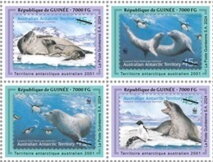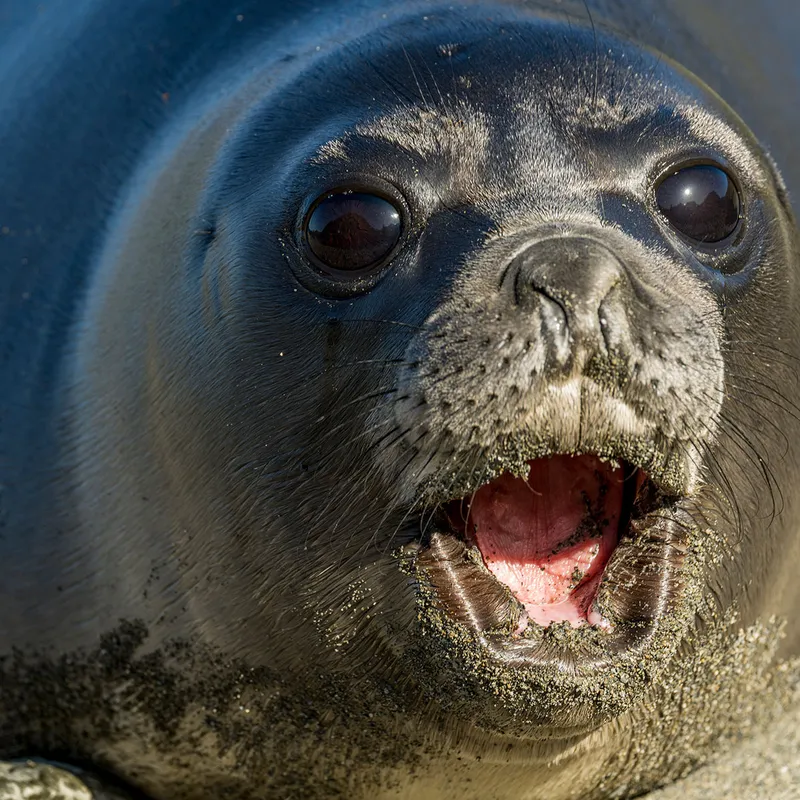Se-tenant: Australian Antarctic - Leopard Seal (Hydrurga leptonyx) (Guinea 2024)
Australian Antarctic - Leopard Seal (Hydrurga leptonyx) (Guinea 2024)
07 March (Guinea ) within release Fauna of the World on Stamps (2024) goes into circulation Se-tenant Australian Antarctic - Leopard Seal (Hydrurga leptonyx) face value 4*7000 Guinean franc
| Se-tenant Australian Antarctic - Leopard Seal (Hydrurga leptonyx) in catalogues | |
|---|---|
| Colnect codes: | Col: GN 2024.03.07-294 |
Se-tenant is square format.
Issued in both full panes of four se-tenant blocks and mini-sheets of two se-tenant blocks.Also in the issue Fauna of the World on Stamps (2024):
- Mini Sheet - Aitutaki - Blue Lorikeet (Vini peruviana) face value 8*7000;
- Full Pane - Aitutaki - Blue Lorikeet (Vini peruviana) face value 16*7000;
- Se-tenant - Aitutaki - Blue Lorikeet (Vini peruviana) face value 4*7000;
- Mini Sheet - Argentina Pampas Deer/Vicugna//Southern Pudu/Chacoan Peccary face value 8*7000;
- Full Pane - Argentina Pampas Deer/Vicugna//Southern Pudu/Chacoan Peccary face value 16*7000;
- Se-tenant - Argentina Pampas Deer/Vicugna//Southern Pudu/Chacoan Peccary face value 4*7000;
- Mini Sheet - Armenia - Bezoar Ibex (Capra aegagrus aegagrus) face value 8*7000;
- Full Pane - Armenia - Bezoar Ibex (Capra aegagrus aegagrus) face value 16*7000;
- Se-tenant - Armenia - Bezoar Ibex (Capra aegagrus aegagrus) face value 4*7000;
- Mini Sheet - Australia - Birds face value 8*7000;
- Full Pane - Australia - Birds face value 16*7000;
- Se-tenant - Australia - Birds face value 4*7000;
- Mini Sheet - Australian Antarctic - Leopard Seal (Hydrurga leptonyx) face value 8*7000;
- Full Pane - Australian Antarctic - Leopard Seal (Hydrurga leptonyx) face value 16*7000;
- Se-tenant - Australian Antarctic - Leopard Seal (Hydrurga leptonyx) face value 4*7000;
Se-tenant Australian Antarctic - Leopard Seal (Hydrurga leptonyx) it reflects the thematic directions:
Animals are multicellular, eukaryotic organisms of the kingdom Animalia (also called Metazoa). All animals are motile, meaning they can move spontaneously and independently, at some point in their lives. Their body plan eventually becomes fixed as they develop, although some undergo a process of metamorphosis later on in their lives. All animals are heterotrophs: they must ingest other organisms or their products for sustenance.
Marine mammals are mammals that rely on marine (saltwater) ecosystems for their existence. They include animals such as cetaceans (whales, dolphins and porpoises), pinnipeds (seals, sea lions and walruses), sirenians (manatees and dugongs), sea otters and polar bears. They are an informal group, unified only by their reliance on marine environments for feeding and survival.
Marine life, or sea life or ocean life, refers to the plants, animals and other organisms that live in the salt water of the sea or ocean, or the brackish water of coastal estuaries. At a fundamental level, marine life helps determine the very nature of our planet. Marine organisms produce much of the oxygen we breathe. Shorelines are in part shaped and protected by marine life, and some marine organisms even help create new land. Altogether there are 230,000 documented marine species, including over 16,000 species of fish, and it has been estimated that nearly two million marine species are yet to be documented. Marine species range in size from the microscopic, including plankton and phytoplankton which can be as small as 0.02 micrometres, to huge cetaceans (whales, dolphins and porpoises) which in the case of the blue whale reach up to 33 metres (109 feet) in length, being the largest known animal.
Pinnipeds (pronounced /ˈpɪnɪˌpɛdz/), commonly known as seals, are a widely distributed and diverse clade of carnivorous, fin-footed, semiaquatic, mostly marine mammals. They comprise the extant families Odobenidae (whose only living member is the walrus), Otariidae (the eared seals: sea lions and fur seals), and Phocidae (the earless seals, or true seals), with 34 extant species and more than 50 extinct species described from fossils. While seals were historically thought to have descended from two ancestral lines, molecular evidence supports them as a monophyletic group (descended from one ancestor). Pinnipeds belong to the suborder Caniformia of the order Carnivora; their closest living relatives are musteloids (weasels, raccoons, skunks and red pandas), having diverged about 50 million years ago.




